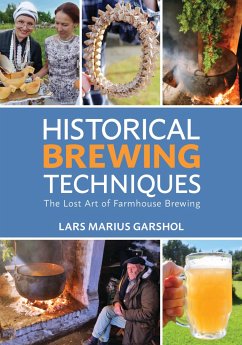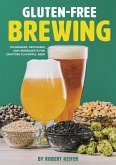Lars Marius Garshol
Historical Brewing Techniques: The Lost Art of Farmhouse Brewing
27,99 €
inkl. MwSt.
Versandfertig in 2-4 Wochen

14 °P sammeln
Lars Marius Garshol
Historical Brewing Techniques: The Lost Art of Farmhouse Brewing
- Broschiertes Buch
- Merkliste
- Auf die Merkliste
- Bewerten Bewerten
- Teilen
- Produkt teilen
- Produkterinnerung
- Produkterinnerung
Equal parts history, cultural anthropology, social science, and travelogue, this book describes brewing and fermentation techniques that are vastly different from modern craft brewing and preserves them for posterity and exploration. Learn about uncovering an unusual strain of yeast, called kveik, which can ferment a batch to completion in just 36 hours. Discover how to make keptinis by baking the mash in the oven. Explore using juniper boughs for various stages of the brewing process.
Andere Kunden interessierten sich auch für
![Gose: Brewing a Classic German Beer for the Modern Era Gose: Brewing a Classic German Beer for the Modern Era]() Fal AllenGose: Brewing a Classic German Beer for the Modern Era22,99 €
Fal AllenGose: Brewing a Classic German Beer for the Modern Era22,99 €![Brewing Eclectic IPA: Pushing the Boundaries of India Pale Ale Brewing Eclectic IPA: Pushing the Boundaries of India Pale Ale]() Dick CantwellBrewing Eclectic IPA: Pushing the Boundaries of India Pale Ale22,99 €
Dick CantwellBrewing Eclectic IPA: Pushing the Boundaries of India Pale Ale22,99 €![IPA: Brewing Techniques, Recipes and the Evolution of India Pale Ale IPA: Brewing Techniques, Recipes and the Evolution of India Pale Ale]() Mitch SteeleIPA: Brewing Techniques, Recipes and the Evolution of India Pale Ale26,99 €
Mitch SteeleIPA: Brewing Techniques, Recipes and the Evolution of India Pale Ale26,99 €![Session Beers: Brewing for Flavor and Balance Session Beers: Brewing for Flavor and Balance]() Jennifer TalleySession Beers: Brewing for Flavor and Balance22,99 €
Jennifer TalleySession Beers: Brewing for Flavor and Balance22,99 €![Beer Town: The Story of Brewing in Burton Upon Trent Beer Town: The Story of Brewing in Burton Upon Trent]() Roger ProtzBeer Town: The Story of Brewing in Burton Upon Trent30,99 €
Roger ProtzBeer Town: The Story of Brewing in Burton Upon Trent30,99 €![Brewing with Wheat Brewing with Wheat]() Stan HieronymusBrewing with Wheat16,99 €
Stan HieronymusBrewing with Wheat16,99 €![Gluten-Free Brewing Gluten-Free Brewing]() Robert KeiferGluten-Free Brewing22,99 €
Robert KeiferGluten-Free Brewing22,99 €-
-
-
Equal parts history, cultural anthropology, social science, and travelogue, this book describes brewing and fermentation techniques that are vastly different from modern craft brewing and preserves them for posterity and exploration. Learn about uncovering an unusual strain of yeast, called kveik, which can ferment a batch to completion in just 36 hours. Discover how to make keptinis by baking the mash in the oven. Explore using juniper boughs for various stages of the brewing process.
Hinweis: Dieser Artikel kann nur an eine deutsche Lieferadresse ausgeliefert werden.
Hinweis: Dieser Artikel kann nur an eine deutsche Lieferadresse ausgeliefert werden.
Produktdetails
- Produktdetails
- Verlag: Brewers Publications
- Seitenzahl: 400
- Erscheinungstermin: 30. April 2020
- Englisch
- Abmessung: 177mm x 246mm x 17mm
- Gewicht: 1028g
- ISBN-13: 9781938469558
- ISBN-10: 1938469550
- Artikelnr.: 57631242
- Herstellerkennzeichnung
- Libri GmbH
- Europaallee 1
- 36244 Bad Hersfeld
- gpsr@libri.de
- Verlag: Brewers Publications
- Seitenzahl: 400
- Erscheinungstermin: 30. April 2020
- Englisch
- Abmessung: 177mm x 246mm x 17mm
- Gewicht: 1028g
- ISBN-13: 9781938469558
- ISBN-10: 1938469550
- Artikelnr.: 57631242
- Herstellerkennzeichnung
- Libri GmbH
- Europaallee 1
- 36244 Bad Hersfeld
- gpsr@libri.de
By Lars Marius Garshol
Table of Contents
1 Understanding farmhouse ale
1.1 The world of yesterday
1.2 Kaupanger: First meeting with the tradition
2 History 35
3 Malt 47
3.1 Stjørdal: malt-making hot spot
3.2 The types of grain
3.3 Barley varieties
3.4 Maskin, portrait of a barley variety
3.5 How the grain was grown
3.6 Steeping and sprouting
3.7 Drying methods
3.7.1 Very pale, unsmoked malts
3.7.2 Lightly smoked, hot-dried malts
3.7.3 Heavily smoked malts
3.7.4 Caramel malts
3.7.5 Strong, uneven heat
3.7.6 Undried malts
4 Yeast 95
4.1 Voss: Discovering kveik
4.2 First lab analysis
4.3 Yeast, wild and domesticated
4.4 The yeast revolution
4.5 Yeast on the farms
4.6 Origins of the yeast
4.7 Yeast species
4.8 The family tree of yeast
4.9 Kveik, what we know
4.10 The non-kveik farmhouse yeasts
4.11 Bread yeast
4.12 Dying out
4.13 Kveik renaissance
4.14 The word "kveik"
5 Brewing process 155
5.1 Hornindal, Norway
5.2 Stone beer
5.3 Raw ale
5.4 Boiled ale
5.5 The mash boiled
5.6 Complex mashes
5.7 Keptinis
5.8 The great stove
5.9 Vsekhsvyatskoye, Russia
5.10 Understanding oven-based beers
5.11 The mash fermented
5.12 The evolution of brewing processes
6 Beer in the life on the farm 217
6.1 Harvest ale
6.2 Ritual beer
6.3 Superstition
6.4 Brewers or brewsters?
6.5 Equipment
6.6 Preparations
6.7 Grinding
6.8 Water
6.9 Carbonation
6.10 Oppskåke
6.11 Cellaring
6.12 Drinking vessels
6.13 Serving beer
6.14 Beer flaws
7 Spices and adjuncts 277
7.1 Hops
7.2 Juniper
7.3 Sweet gale
7.4 Grand wormwood
7.5 Caraway
7.6 St John's Wort
7.7 Bitter orange peel
7.8 Yarrow
7.9 Tansy
7.10 Bay laurel
7.11 Wild rosemary
7.12 Heather
7.13 Others
7.14 Adjuncts
7.14.1 Potatoes
7.14.2 Bran
7.14.3 Carrots
7.14.4 Peas
7.14.5 Honey
7.14.6 Other adjuncts
7.15 Filter materials
7.15.1 Straw
7.15.2 Alder sticks
7.15.3 Other
8 The drink problem
8.1 Small beer
8.2 Rostdrikke
8.3 Kvass
8.4 Birch sap beer
8.5 Juniper berry beer
8.6 Mead
8.7 Sugar beer
9 Brewing like a farmer
9.1 Carbonation
9.2 Working with kveik
9.3 Working with farmhouse yeast
9.4 Brewing with juniper
9.5 Making your own malts
10 Styles and how to brew them
10.1 What is farmhouse ale?
10.2 Recipes
10.3 Raw ales
10.3.1 Brewing raw ales
10.3.2 Kornøl
10.3.3 Sahti
10.3.4 Island koduõlu
10.3.5 Kaimikas
10.3.6 Danish landøl
10.4 Dark, smoky ales
10.4.1 Stjørdalsøl
10.4.2 Gotlandsdricke
10.4.3 Landøl from south Funen
10.5 Brown boiled beers
10.5.1 Heimabrygg
10.5.2 Telemark, Norway
10.5.3 Hallingdal
10.5.4 Swedish farmhouse ale: Öxabäck
10.6 Oven beers
10.6.1 Seto koduõlu
10.6.2 Oven-mashed Russian farmhouse ale
10.6.3 Chuvashian farmhouse ale
10.6.4 Sur
10.6.5 Keptinis
10.7 Fermented mash
10.7.1 Luumäki-style
10.7.2 Vanylven-style
10.8 Stone beer
10.9 Other regions
10.9.1 Corn ale
10.9.2 English farmhouse ale
10.9.3 Welsh farmhouse ale
10.9.4 Westphalian farmhouse ale
10.9.5 Aludi
10.9.6 Oat beer
11 Today and tomorrow
11.1 Baltic time capsule
11.2 The Baltics today
11.3 Status in the west
11.4 Farmhouse ale in the 21st century
11.5 Into the future
12 Acknowledgements
13 Bibliography
13.1 Archive sources
13.2 The database
13.3 Published sources
13.4 Unpublished sources
13.5 Interview sources
1 Understanding farmhouse ale
1.1 The world of yesterday
1.2 Kaupanger: First meeting with the tradition
2 History 35
3 Malt 47
3.1 Stjørdal: malt-making hot spot
3.2 The types of grain
3.3 Barley varieties
3.4 Maskin, portrait of a barley variety
3.5 How the grain was grown
3.6 Steeping and sprouting
3.7 Drying methods
3.7.1 Very pale, unsmoked malts
3.7.2 Lightly smoked, hot-dried malts
3.7.3 Heavily smoked malts
3.7.4 Caramel malts
3.7.5 Strong, uneven heat
3.7.6 Undried malts
4 Yeast 95
4.1 Voss: Discovering kveik
4.2 First lab analysis
4.3 Yeast, wild and domesticated
4.4 The yeast revolution
4.5 Yeast on the farms
4.6 Origins of the yeast
4.7 Yeast species
4.8 The family tree of yeast
4.9 Kveik, what we know
4.10 The non-kveik farmhouse yeasts
4.11 Bread yeast
4.12 Dying out
4.13 Kveik renaissance
4.14 The word "kveik"
5 Brewing process 155
5.1 Hornindal, Norway
5.2 Stone beer
5.3 Raw ale
5.4 Boiled ale
5.5 The mash boiled
5.6 Complex mashes
5.7 Keptinis
5.8 The great stove
5.9 Vsekhsvyatskoye, Russia
5.10 Understanding oven-based beers
5.11 The mash fermented
5.12 The evolution of brewing processes
6 Beer in the life on the farm 217
6.1 Harvest ale
6.2 Ritual beer
6.3 Superstition
6.4 Brewers or brewsters?
6.5 Equipment
6.6 Preparations
6.7 Grinding
6.8 Water
6.9 Carbonation
6.10 Oppskåke
6.11 Cellaring
6.12 Drinking vessels
6.13 Serving beer
6.14 Beer flaws
7 Spices and adjuncts 277
7.1 Hops
7.2 Juniper
7.3 Sweet gale
7.4 Grand wormwood
7.5 Caraway
7.6 St John's Wort
7.7 Bitter orange peel
7.8 Yarrow
7.9 Tansy
7.10 Bay laurel
7.11 Wild rosemary
7.12 Heather
7.13 Others
7.14 Adjuncts
7.14.1 Potatoes
7.14.2 Bran
7.14.3 Carrots
7.14.4 Peas
7.14.5 Honey
7.14.6 Other adjuncts
7.15 Filter materials
7.15.1 Straw
7.15.2 Alder sticks
7.15.3 Other
8 The drink problem
8.1 Small beer
8.2 Rostdrikke
8.3 Kvass
8.4 Birch sap beer
8.5 Juniper berry beer
8.6 Mead
8.7 Sugar beer
9 Brewing like a farmer
9.1 Carbonation
9.2 Working with kveik
9.3 Working with farmhouse yeast
9.4 Brewing with juniper
9.5 Making your own malts
10 Styles and how to brew them
10.1 What is farmhouse ale?
10.2 Recipes
10.3 Raw ales
10.3.1 Brewing raw ales
10.3.2 Kornøl
10.3.3 Sahti
10.3.4 Island koduõlu
10.3.5 Kaimikas
10.3.6 Danish landøl
10.4 Dark, smoky ales
10.4.1 Stjørdalsøl
10.4.2 Gotlandsdricke
10.4.3 Landøl from south Funen
10.5 Brown boiled beers
10.5.1 Heimabrygg
10.5.2 Telemark, Norway
10.5.3 Hallingdal
10.5.4 Swedish farmhouse ale: Öxabäck
10.6 Oven beers
10.6.1 Seto koduõlu
10.6.2 Oven-mashed Russian farmhouse ale
10.6.3 Chuvashian farmhouse ale
10.6.4 Sur
10.6.5 Keptinis
10.7 Fermented mash
10.7.1 Luumäki-style
10.7.2 Vanylven-style
10.8 Stone beer
10.9 Other regions
10.9.1 Corn ale
10.9.2 English farmhouse ale
10.9.3 Welsh farmhouse ale
10.9.4 Westphalian farmhouse ale
10.9.5 Aludi
10.9.6 Oat beer
11 Today and tomorrow
11.1 Baltic time capsule
11.2 The Baltics today
11.3 Status in the west
11.4 Farmhouse ale in the 21st century
11.5 Into the future
12 Acknowledgements
13 Bibliography
13.1 Archive sources
13.2 The database
13.3 Published sources
13.4 Unpublished sources
13.5 Interview sources
Table of Contents
1 Understanding farmhouse ale
1.1 The world of yesterday
1.2 Kaupanger: First meeting with the tradition
2 History 35
3 Malt 47
3.1 Stjørdal: malt-making hot spot
3.2 The types of grain
3.3 Barley varieties
3.4 Maskin, portrait of a barley variety
3.5 How the grain was grown
3.6 Steeping and sprouting
3.7 Drying methods
3.7.1 Very pale, unsmoked malts
3.7.2 Lightly smoked, hot-dried malts
3.7.3 Heavily smoked malts
3.7.4 Caramel malts
3.7.5 Strong, uneven heat
3.7.6 Undried malts
4 Yeast 95
4.1 Voss: Discovering kveik
4.2 First lab analysis
4.3 Yeast, wild and domesticated
4.4 The yeast revolution
4.5 Yeast on the farms
4.6 Origins of the yeast
4.7 Yeast species
4.8 The family tree of yeast
4.9 Kveik, what we know
4.10 The non-kveik farmhouse yeasts
4.11 Bread yeast
4.12 Dying out
4.13 Kveik renaissance
4.14 The word "kveik"
5 Brewing process 155
5.1 Hornindal, Norway
5.2 Stone beer
5.3 Raw ale
5.4 Boiled ale
5.5 The mash boiled
5.6 Complex mashes
5.7 Keptinis
5.8 The great stove
5.9 Vsekhsvyatskoye, Russia
5.10 Understanding oven-based beers
5.11 The mash fermented
5.12 The evolution of brewing processes
6 Beer in the life on the farm 217
6.1 Harvest ale
6.2 Ritual beer
6.3 Superstition
6.4 Brewers or brewsters?
6.5 Equipment
6.6 Preparations
6.7 Grinding
6.8 Water
6.9 Carbonation
6.10 Oppskåke
6.11 Cellaring
6.12 Drinking vessels
6.13 Serving beer
6.14 Beer flaws
7 Spices and adjuncts 277
7.1 Hops
7.2 Juniper
7.3 Sweet gale
7.4 Grand wormwood
7.5 Caraway
7.6 St John's Wort
7.7 Bitter orange peel
7.8 Yarrow
7.9 Tansy
7.10 Bay laurel
7.11 Wild rosemary
7.12 Heather
7.13 Others
7.14 Adjuncts
7.14.1 Potatoes
7.14.2 Bran
7.14.3 Carrots
7.14.4 Peas
7.14.5 Honey
7.14.6 Other adjuncts
7.15 Filter materials
7.15.1 Straw
7.15.2 Alder sticks
7.15.3 Other
8 The drink problem
8.1 Small beer
8.2 Rostdrikke
8.3 Kvass
8.4 Birch sap beer
8.5 Juniper berry beer
8.6 Mead
8.7 Sugar beer
9 Brewing like a farmer
9.1 Carbonation
9.2 Working with kveik
9.3 Working with farmhouse yeast
9.4 Brewing with juniper
9.5 Making your own malts
10 Styles and how to brew them
10.1 What is farmhouse ale?
10.2 Recipes
10.3 Raw ales
10.3.1 Brewing raw ales
10.3.2 Kornøl
10.3.3 Sahti
10.3.4 Island koduõlu
10.3.5 Kaimikas
10.3.6 Danish landøl
10.4 Dark, smoky ales
10.4.1 Stjørdalsøl
10.4.2 Gotlandsdricke
10.4.3 Landøl from south Funen
10.5 Brown boiled beers
10.5.1 Heimabrygg
10.5.2 Telemark, Norway
10.5.3 Hallingdal
10.5.4 Swedish farmhouse ale: Öxabäck
10.6 Oven beers
10.6.1 Seto koduõlu
10.6.2 Oven-mashed Russian farmhouse ale
10.6.3 Chuvashian farmhouse ale
10.6.4 Sur
10.6.5 Keptinis
10.7 Fermented mash
10.7.1 Luumäki-style
10.7.2 Vanylven-style
10.8 Stone beer
10.9 Other regions
10.9.1 Corn ale
10.9.2 English farmhouse ale
10.9.3 Welsh farmhouse ale
10.9.4 Westphalian farmhouse ale
10.9.5 Aludi
10.9.6 Oat beer
11 Today and tomorrow
11.1 Baltic time capsule
11.2 The Baltics today
11.3 Status in the west
11.4 Farmhouse ale in the 21st century
11.5 Into the future
12 Acknowledgements
13 Bibliography
13.1 Archive sources
13.2 The database
13.3 Published sources
13.4 Unpublished sources
13.5 Interview sources
1 Understanding farmhouse ale
1.1 The world of yesterday
1.2 Kaupanger: First meeting with the tradition
2 History 35
3 Malt 47
3.1 Stjørdal: malt-making hot spot
3.2 The types of grain
3.3 Barley varieties
3.4 Maskin, portrait of a barley variety
3.5 How the grain was grown
3.6 Steeping and sprouting
3.7 Drying methods
3.7.1 Very pale, unsmoked malts
3.7.2 Lightly smoked, hot-dried malts
3.7.3 Heavily smoked malts
3.7.4 Caramel malts
3.7.5 Strong, uneven heat
3.7.6 Undried malts
4 Yeast 95
4.1 Voss: Discovering kveik
4.2 First lab analysis
4.3 Yeast, wild and domesticated
4.4 The yeast revolution
4.5 Yeast on the farms
4.6 Origins of the yeast
4.7 Yeast species
4.8 The family tree of yeast
4.9 Kveik, what we know
4.10 The non-kveik farmhouse yeasts
4.11 Bread yeast
4.12 Dying out
4.13 Kveik renaissance
4.14 The word "kveik"
5 Brewing process 155
5.1 Hornindal, Norway
5.2 Stone beer
5.3 Raw ale
5.4 Boiled ale
5.5 The mash boiled
5.6 Complex mashes
5.7 Keptinis
5.8 The great stove
5.9 Vsekhsvyatskoye, Russia
5.10 Understanding oven-based beers
5.11 The mash fermented
5.12 The evolution of brewing processes
6 Beer in the life on the farm 217
6.1 Harvest ale
6.2 Ritual beer
6.3 Superstition
6.4 Brewers or brewsters?
6.5 Equipment
6.6 Preparations
6.7 Grinding
6.8 Water
6.9 Carbonation
6.10 Oppskåke
6.11 Cellaring
6.12 Drinking vessels
6.13 Serving beer
6.14 Beer flaws
7 Spices and adjuncts 277
7.1 Hops
7.2 Juniper
7.3 Sweet gale
7.4 Grand wormwood
7.5 Caraway
7.6 St John's Wort
7.7 Bitter orange peel
7.8 Yarrow
7.9 Tansy
7.10 Bay laurel
7.11 Wild rosemary
7.12 Heather
7.13 Others
7.14 Adjuncts
7.14.1 Potatoes
7.14.2 Bran
7.14.3 Carrots
7.14.4 Peas
7.14.5 Honey
7.14.6 Other adjuncts
7.15 Filter materials
7.15.1 Straw
7.15.2 Alder sticks
7.15.3 Other
8 The drink problem
8.1 Small beer
8.2 Rostdrikke
8.3 Kvass
8.4 Birch sap beer
8.5 Juniper berry beer
8.6 Mead
8.7 Sugar beer
9 Brewing like a farmer
9.1 Carbonation
9.2 Working with kveik
9.3 Working with farmhouse yeast
9.4 Brewing with juniper
9.5 Making your own malts
10 Styles and how to brew them
10.1 What is farmhouse ale?
10.2 Recipes
10.3 Raw ales
10.3.1 Brewing raw ales
10.3.2 Kornøl
10.3.3 Sahti
10.3.4 Island koduõlu
10.3.5 Kaimikas
10.3.6 Danish landøl
10.4 Dark, smoky ales
10.4.1 Stjørdalsøl
10.4.2 Gotlandsdricke
10.4.3 Landøl from south Funen
10.5 Brown boiled beers
10.5.1 Heimabrygg
10.5.2 Telemark, Norway
10.5.3 Hallingdal
10.5.4 Swedish farmhouse ale: Öxabäck
10.6 Oven beers
10.6.1 Seto koduõlu
10.6.2 Oven-mashed Russian farmhouse ale
10.6.3 Chuvashian farmhouse ale
10.6.4 Sur
10.6.5 Keptinis
10.7 Fermented mash
10.7.1 Luumäki-style
10.7.2 Vanylven-style
10.8 Stone beer
10.9 Other regions
10.9.1 Corn ale
10.9.2 English farmhouse ale
10.9.3 Welsh farmhouse ale
10.9.4 Westphalian farmhouse ale
10.9.5 Aludi
10.9.6 Oat beer
11 Today and tomorrow
11.1 Baltic time capsule
11.2 The Baltics today
11.3 Status in the west
11.4 Farmhouse ale in the 21st century
11.5 Into the future
12 Acknowledgements
13 Bibliography
13.1 Archive sources
13.2 The database
13.3 Published sources
13.4 Unpublished sources
13.5 Interview sources







